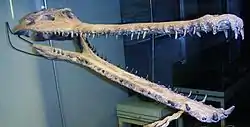Piscogavialis
Piscogavialis is an extinct genus of gryposuchine gavialid crocodylian. The only species yet known is P. jugaliperforatus. Fossils of Piscogavialis have been found from the Mio-Pliocene Pisco Formation of the Sacaco Basin in southern Peru in 1998.[1] It is the first reptile known from the formation, which is otherwise notable for its high diversity of fossil vertebrates.[2]
| Piscogavialis | |
|---|---|
 | |
| Skull | |
| Scientific classification | |
| Kingdom: | Animalia |
| Phylum: | Chordata |
| Class: | Reptilia |
| Order: | Crocodilia |
| Family: | Gavialidae |
| Subfamily: | †Gryposuchinae |
| Genus: | †Piscogavialis Kraus 1998 |
| Type species | |
| †Piscogavialis jugaliperforatus | |
Piscogavialis is known only from a single specimen, but it represents some of the best preserved gavialid material known from South America. The skull is preserved in three dimensions and is nearly complete. A mandible and some postcranial material have also been found in association with the skull. Several important features of the occipital region of the skull support a referral to the family Gavialidae, which also includes the extant gharial and false gharial.
Paleobiology
The strata from which remains of Piscogavialis have been found suggest that it lived in a coastal environment.[2][3] Another extinct gavialid, Siquisiquesuchus, is also known to have lived in a coastal setting.[4] The presence of other gryposuchines in coastal strata may be an indication that all members of the subfamily inhabited coastal environments.[5][6] However, some gryposuchines have been found from localities that clearly represent non-marine environments.[7]
References
- Piscogavialis at Fossilworks.org
- Kraus, R. M. (1998). "The cranium of Piscogavialis jugaliperforatus n.gen., n.sp. (Gavialidae, Crocodylia) from the Miocene of Peru". Paläontologische Zeitschrift. 72 (3): 389–406. doi:10.1007/bf02988368.
- Vélez-Juarbe, J.; Brochu, C. A.; Santos, H. (2007). "A gharial from the Oligocene of Puerto Rico: transoceanic dispersal in the history of a non-marine reptile". Proceedings of the Royal Society B. 274 (1615): 1245–1254. doi:10.1098/rspb.2006.0455. PMC 2176176. PMID 17341454.
- Brochu, C. A.; Rincon, A. D. (2004). "A gavialoid crocodylian from the Lower Miocene of Venezuela". Special Papers in Palaeontology. 71: 61–78.
- Iturralde-Vinent, M. A.; MacPhee, R. D. E. (1999). "Paleogeography of the Caribbean region: implications for Cenozoic biogeography". Bulletin of the American Museum of Natural History. 238: 1–95.
- Sánchez-Villagra, M. R.; Aguilera, O. A. (2006). "Neogene vertebrates from Urumaco, Falcón State, Venezuela: diversity and significance". Journal of Systematic Palaeontology. 4 (3): 213–220. doi:10.1017/S1477201906001829.
- Kay, R. F.; Madden, R. H. (1997). "Paleogeography and paleoecology". In R. F. Kay; R. H. Madden; R. L. Cifelli; J. J. Flynn (eds.). Vertebrate paleontology in the neotropics: the Miocene fauna of La Venta, Colombia. Washington, D. C.: Smithsonian Institution Press. pp. 520–550. ISBN 1-56098-418-X.